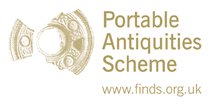Server check!
You are on the training database
Portable Antiquities Annual Report 2014
A full copy of the report can be downloaded as a pdf (2MB)
Through the Portable Antiquities Scheme (PAS) people are rewriting the history of England and Wales. Whether or not the finds recorded are unique, aesthetically pleasing, damaged or broken, they all have their own stories to tell, enabling people to understand better the archaeology of Britain and their local area. These finds also drive academic research, and help archaeologists protect the historic environment.
Key to the PAS's success is the fact that so many people are willing to share their finds, of which 113,794 were recorded in 2014. It is important that these discoveries are recovered according to best practice to avoid accidental damage to archaeology, which finders can help do by following the Code of Practice for Responsible Metal Detecting.
I would also like to pay particular tribute to the PAS's network of Finds Liaison Officers (FLOs), their managers and the local partners that host them, as well as the interns and volunteers who work alongside them - once again the Headley Trust has kindly supported another tranche of PAS interns which have made a tremendous impact. Through the PASt Explorers Programme, supported by the Heritage Lottery Fund (HLF), more people are now volunteering with the PAS, undertaking finds-related work, and helping to share knowledge about archaeological finds. Importantly, PAS finds recording work is also supported by experts in museums, universities and heritage organisations across the country, to whom we are also indebted.
The PAS also has an important role in ensuring the effective working of the Treasure Act, of which a further 1,008 cases were reported in 2014. The most important finds have been acquired by museums (166 in 2013), as the process allows, of which 119 have been donated. The Treasure team and colleagues at the British Museum, museum curators across the country, the network of national coroners and the Treasure Valuation Committee have all worked hard to ensure the process works as smoothly and efficiently as possible. I would like to extend my gratitude to those who have generously supported museums in securing Treasure acquisitions this year: the Art Fund, the Headley Trust, the National Heritage Memorial Fund and the HLF, and the V&A Purchase Grant Fund.
The PAS is a key part of the British Museum's work, complementing other aspects of our national programme. Looking forward, the British Museum is keen to build on the success of these partnerships to benefit people across the UK, and help take forward the excellent work of the PAS.
Neil MacGregor
Director, British Museum
December 2015
The main achievements of the PAS in 2014:
• 113,794 finds were recorded; a total of 1,127,586 recorded on its database (finds.org.uk/database) to date.
• 96% of finds were found by metal-detectorists.
• 91% of finds were found on cultivated land, where they are susceptible to plough damage and artificial and natural corrosion processes.
• 99% of PAS finds were recorded to the nearest 100m2 (a 6-figure NGR), the minimum requirement for findspot information for Historic Environment Records.
• New sites discovered through finds recorded by the PAS include a Neolithic ceremonial monument from West Yorkshire, an Iron Age farmstead in Shropshire, a Roman furnace for iron smelting in Wiltshire, and skirmish sites associated with the English Civil War in Lincolnshire and Worcestershire.
• Currently 830 people have full access to PAS data for research purposes, and there are a further 8,527 registered users. To date, PAS data has been used in 455 research projects, including 20 pieces of large-scale research and 95 PhDs.
• 499,481 unique visitors visited the PAS websites and database, making 789,253 visits and 5,214,822 page requests.
• Publications associated with the work of the PAS include reports in Britannia, Medieval Archaeology and Post-Medieval Archaeology.
• 1,432 outreach events took place, including talks, finds days and exhibitions. These were attended by at least 39,442 adults and 2,597 children.
• The Scheme's Finds Liaison Officers had regular contact with 197 metal-detecting clubs, attending 856 club meetings.
The main achievements of the Treasure Act 1996 in 2014:
• 1,008 Treasure cases were reported. It is hoped that many of these will be acquired by museums for public benefit.
• 96% of Treasure finds were found by metal-detectorists.
• Important new Treasure finds included a Roman jewellery and coin hoard from Fenwick, Essex (2014 T577), an early medieval zoomorphic pendant (2014 T886) from Market Weighton, East Yorkshire, and a hoard of 5,248 late Anglo-Saxon coins from Lenborough, Buckinghamshire (2014 T973).
In 2013, 166 parties waived their right to a reward for 119 Treasure cases, allowing them to be acquired by museums at no or reduced cost. Most PAS finds are returned to the finder.


